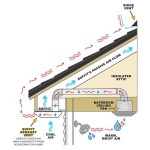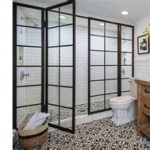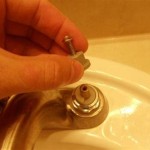Round Bathroom Sink Units: A Comprehensive Guide
Round bathroom sink units represent a versatile and aesthetically pleasing option for a variety of bathroom designs. These units, characterized by their curved shape, offer a softer visual contrast to the often angular and geometric elements found in bathrooms. The following article provides an in-depth exploration of round bathroom sink units, encompassing their diverse types, material options, installation considerations, and design implications.
Types of Round Bathroom Sink Units
The classification of round bathroom sink units can be broadly categorized based on their installation style and overall design. Each type offers distinct advantages and suits different bathroom spatial constraints and aesthetic preferences.
Vessel Sinks: Vessel sinks, also known as above-counter sinks, sit directly on top of the bathroom countertop. This style creates a pronounced focal point and allows for a wide range of design expressions, from minimalist modern to rustic farmhouse. Vessel sinks typically require a taller faucet to accommodate the height of the sink basin. Installation is generally straightforward, often involving only a drain connection and securing the sink to the countertop with sealant. However, considerations regarding counter height are crucial to ensure comfortable use.
Undermount Sinks: Undermount sinks are installed beneath the countertop, creating a seamless and clean aesthetic. This installation method maximizes countertop space and facilitates easy cleaning, as debris can be wiped directly into the sink without encountering a raised edge. Undermount sinks require a solid surface countertop material, such as granite, quartz, or marble, to support the sink’s weight and provide a watertight seal. Installation is more complex than vessel sinks, requiring precise cutting and sealing of the countertop opening.
Drop-in Sinks: Also known as self-rimming sinks, drop-in sinks feature a rim that rests on the countertop. This type of sink is relatively easy to install, requiring only that the rim fit snugly within a pre-cut hole in the countertop. Drop-in sinks offer a balance between the visual prominence of vessel sinks and the space-saving benefits of undermount sinks. The rim can be designed to complement the sink basin or contrast with the countertop material, adding a design element.
Wall-Mounted Sinks: Wall-mounted round sinks are directly attached to the wall, eliminating the need for a countertop or vanity. This style is ideal for small bathrooms or powder rooms where maximizing floor space is a priority. Wall-mounted sinks offer a minimalist and modern aesthetic and can create a sense of openness in the bathroom. Installation requires careful planning to ensure that the wall structure can support the weight of the sink and that plumbing connections are properly concealed. The lack of integrated storage necessitates alternative solutions for toiletries and bathroom essentials.
Pedestal Sinks: Pedestal sinks consist of a sink basin mounted on a freestanding pedestal. This classic design provides a clean and elegant look, often found in traditional or transitional bathrooms. Pedestal sinks conceal the plumbing while offering a relatively compact footprint. However, like wall-mounted sinks, they lack integrated storage, requiring the use of separate storage solutions. Installation involves securing the pedestal to the floor and connecting the plumbing.
Material Options for Round Bathroom Sink Units
The material from which a round bathroom sink unit is constructed significantly impacts its durability, appearance, and maintenance requirements. A wide range of materials are available, each with its own unique characteristics.
Ceramic: Ceramic, including porcelain and vitreous china, is a common and affordable material for bathroom sinks. Ceramic sinks are durable, stain-resistant, and easy to clean. They are available in a wide range of colors and finishes, allowing for versatility in design. However, ceramic can be susceptible to chipping or cracking if subjected to significant impact. Porcelain and vitreous china are denser and less porous than standard ceramic, offering improved durability and stain resistance.
Glass: Glass sinks offer a unique and visually striking aesthetic. They can be clear, frosted, colored, or textured, adding a decorative element to the bathroom. Glass sinks are non-porous and easy to clean, but they can be more fragile than other materials and may be prone to scratching or staining. Tempered glass is recommended for bathroom sinks to enhance durability and safety. The visibility of the sink's underside requires careful attention to plumbing aesthetics.
Stone: Stone sinks, such as marble, granite, or travertine, provide a luxurious and natural look. Each stone sink is unique, with variations in color and veining. Stone is durable and resistant to heat, but it can be porous and require regular sealing to prevent staining. Marble is particularly susceptible to etching from acidic substances. Stone sinks are typically heavier than other materials and require a robust support structure.
Stainless Steel: Stainless steel sinks offer a modern and industrial aesthetic. They are durable, stain-resistant, and easy to clean. Stainless steel is also resistant to corrosion and rust. However, stainless steel sinks can be prone to scratching and may show water spots or fingerprints. The reflective surface can also be a consideration in bathroom lighting design.
Copper: Copper sinks provide a warm and rustic aesthetic. Copper is naturally antimicrobial and resistant to corrosion. Over time, copper develops a patina, which adds to its character. Copper sinks can be more expensive than other materials and may require special cleaning products to maintain their appearance. The reactive nature of copper means it can change color and appearance based on water pH and cleaning products used.
Concrete: Concrete sinks offer a modern and industrial aesthetic. They can be custom-made in various shapes and colors. Concrete is durable, but it can be porous and require sealing to prevent staining. Concrete sinks can be heavy and require a robust support structure. The texture and finish of concrete can vary widely depending on the manufacturing process.
Installation and Design Considerations
Proper installation and careful consideration of design elements are essential for ensuring the functionality and aesthetic appeal of a round bathroom sink unit.
Countertop Compatibility: The choice of countertop material should complement the sink material and installation style. Solid surface countertops, such as granite or quartz, are ideal for undermount sinks, while laminate or wood countertops may be suitable for drop-in or vessel sinks. The color and texture of the countertop should harmonize with the sink and other bathroom fixtures.
Faucet Selection: The faucet style should complement the sink design and functionality. Vessel sinks typically require taller faucets to accommodate the height of the sink basin. Wall-mounted faucets can be used with any type of sink, but they require careful planning for plumbing connections. The finish of the faucet should match the other bathroom fixtures, such as the showerhead and towel bars.
Plumbing Considerations: Plumbing connections should be properly installed and concealed to maintain a clean and organized look. The drain location and water supply lines should be compatible with the sink and faucet. Adequate drainage is essential to prevent water from pooling in the sink basin. In some cases, relocating plumbing lines may be necessary to accommodate the new sink unit.
Space Planning: The size and placement of the sink unit should be appropriate for the size of the bathroom. Small bathrooms may benefit from wall-mounted or pedestal sinks to maximize floor space. Larger bathrooms can accommodate larger sink units with ample countertop space. The sink should be positioned at a comfortable height for users.
Aesthetic Integration: The round shape of the sink unit can be used to soften the angular lines of the bathroom. Round mirrors, curved shower curtains, and other rounded elements can enhance the overall aesthetic coherence. The color and material of the sink unit should complement the existing bathroom décor. Consider the overall style of the bathroom, whether it is modern, traditional, or transitional, and choose a sink unit that reflects that style.
Lighting: Proper lighting is essential for creating a functional and visually appealing bathroom. Task lighting should be positioned above the sink to provide adequate illumination for grooming activities. Ambient lighting can be used to create a relaxing and inviting atmosphere. Consider using dimmer switches to adjust the lighting levels to suit different needs.
Accessibility: For users with disabilities or mobility limitations, accessibility considerations are paramount. Ensure that the sink is at a comfortable height and that there is adequate space underneath the sink for wheelchair access. Lever-style faucets are easier to operate than knob-style faucets. Consider installing grab bars near the sink for added safety and support.
Round bathroom sink units offer a diverse range of design options and functional benefits. By carefully considering the type, material, installation, and design elements, one can create a bathroom that is both aesthetically pleasing and practical.

Round Bathroom Vanity Set With Oval Mirror Or Medicine Cabinet For Small

460mm Vanity Unit Solid Oak With Round Basin And Tap Set Cube

Arezzo 1100 Matt Blue Semi Recessed Round Combination Vanity Unit Chrome Flush Handles Victorian Plumbing
Oak Vanity Unit With Round Marble Sink Bathroom Prestige Mobel

650mm Wooden Wall Hung Countertop Vanity Unit With Round Basin Matira Better Bathrooms

Hangzhou Furniture Wall Mount Bathroom Cabinet With Counter Top Basin European Moden Style Vessel Sink Round Bath Mirror Ceramic Vanity China

600mm White Wall Hung Countertop Vanity Unit With Marble Effect Basin And Shelves Lugo Better Bathrooms

Nuie Mayford Floor Standing 2 Door Vanity Unit With Round Basin 550mm Wide White

Turin 500mm Gloss White 1 Drawer Wall Hung Unit 460mm Round Countertop Basin Royal Bathrooms

Lyndon 600mm Grey Bathroom Freestanding Vanity Unit Round Ceramic Countertop Diy At B Q
Related Posts







